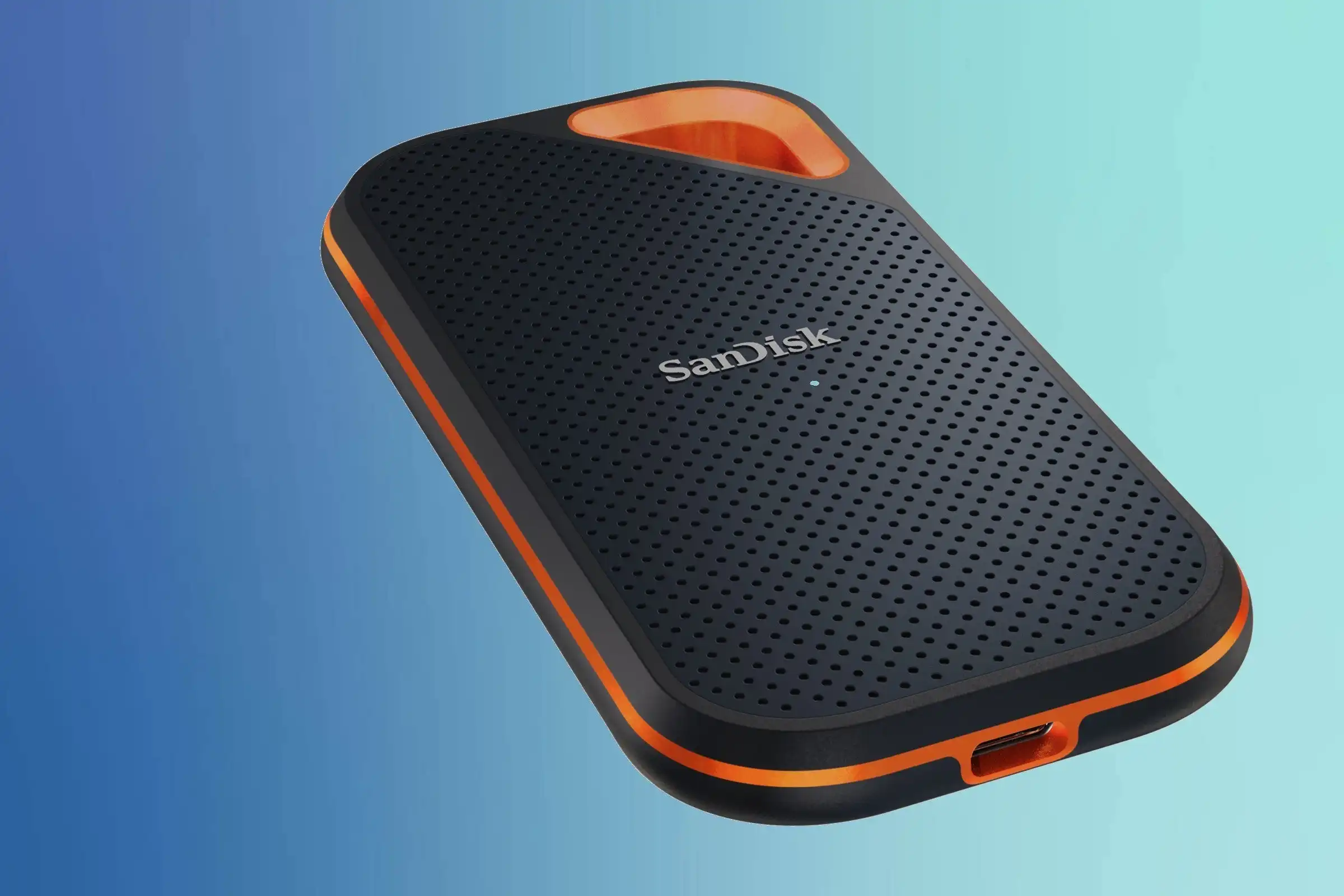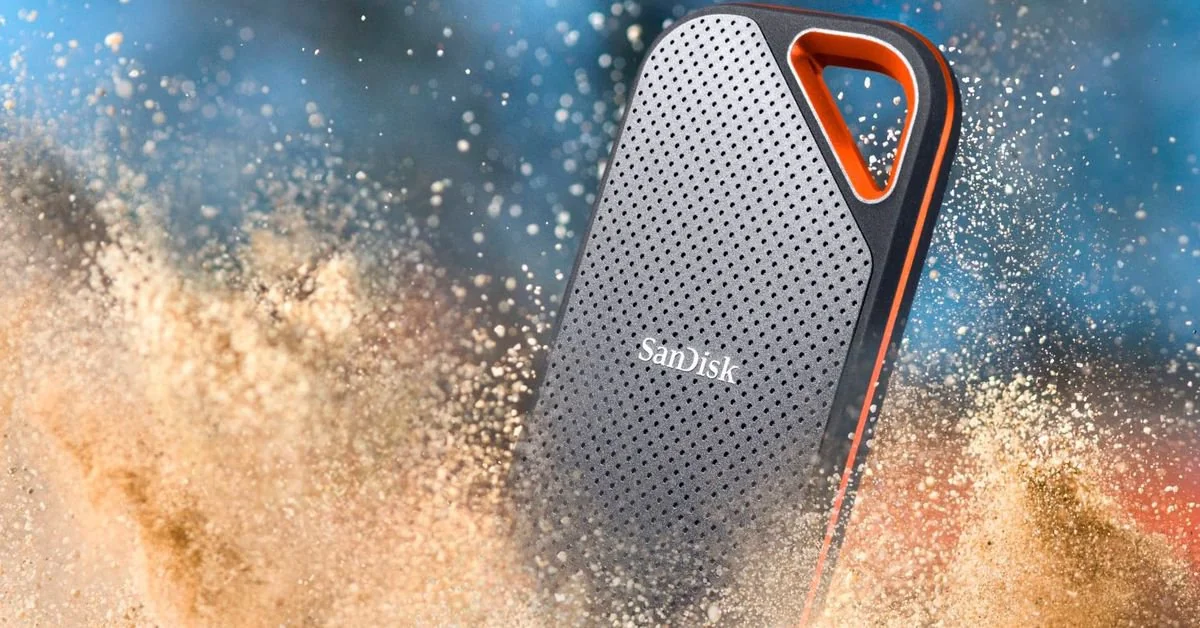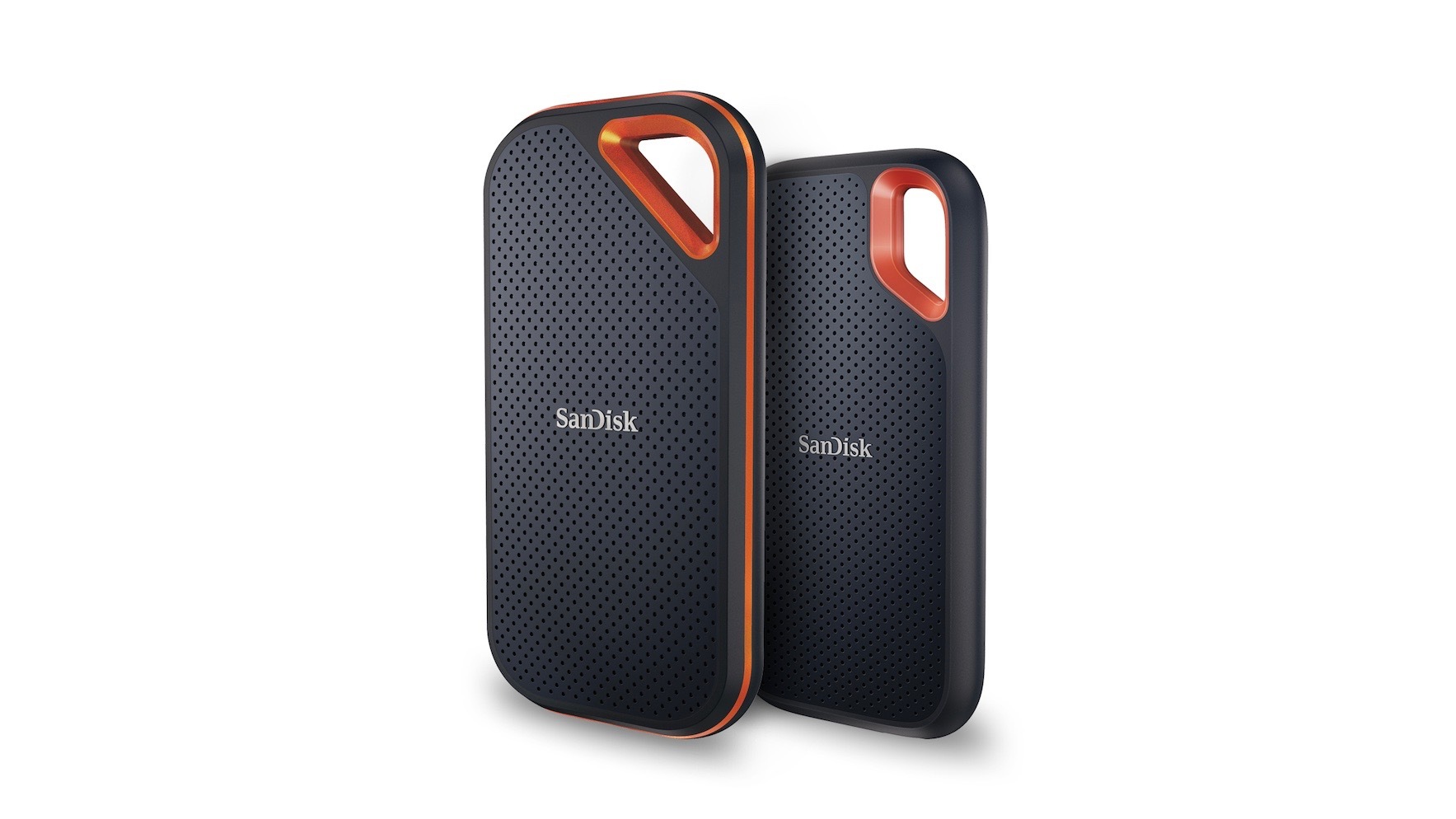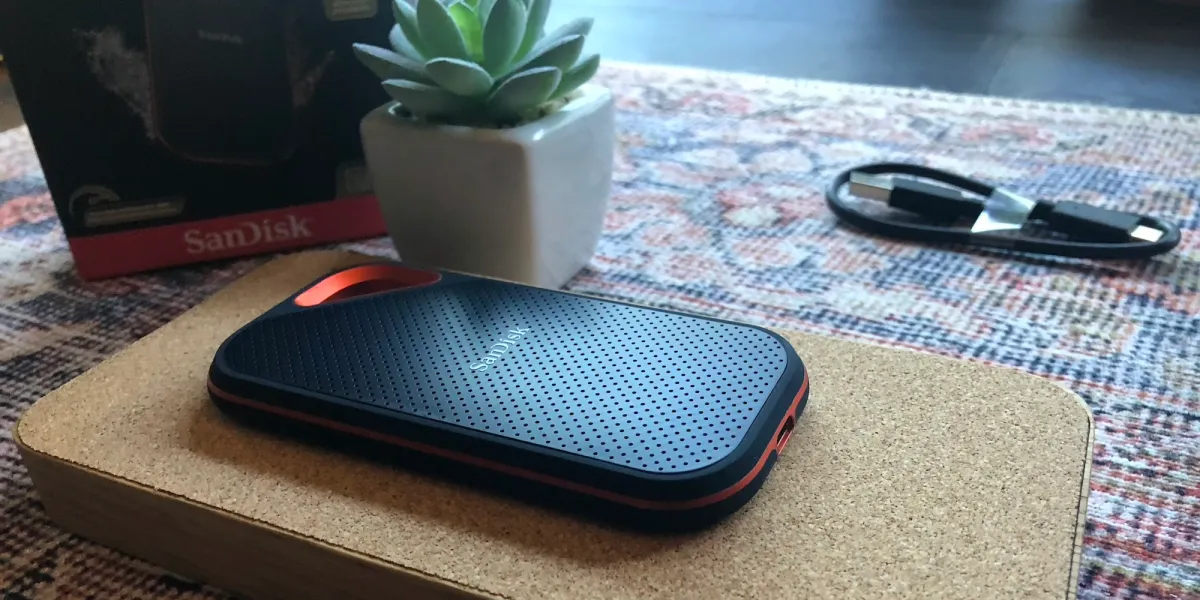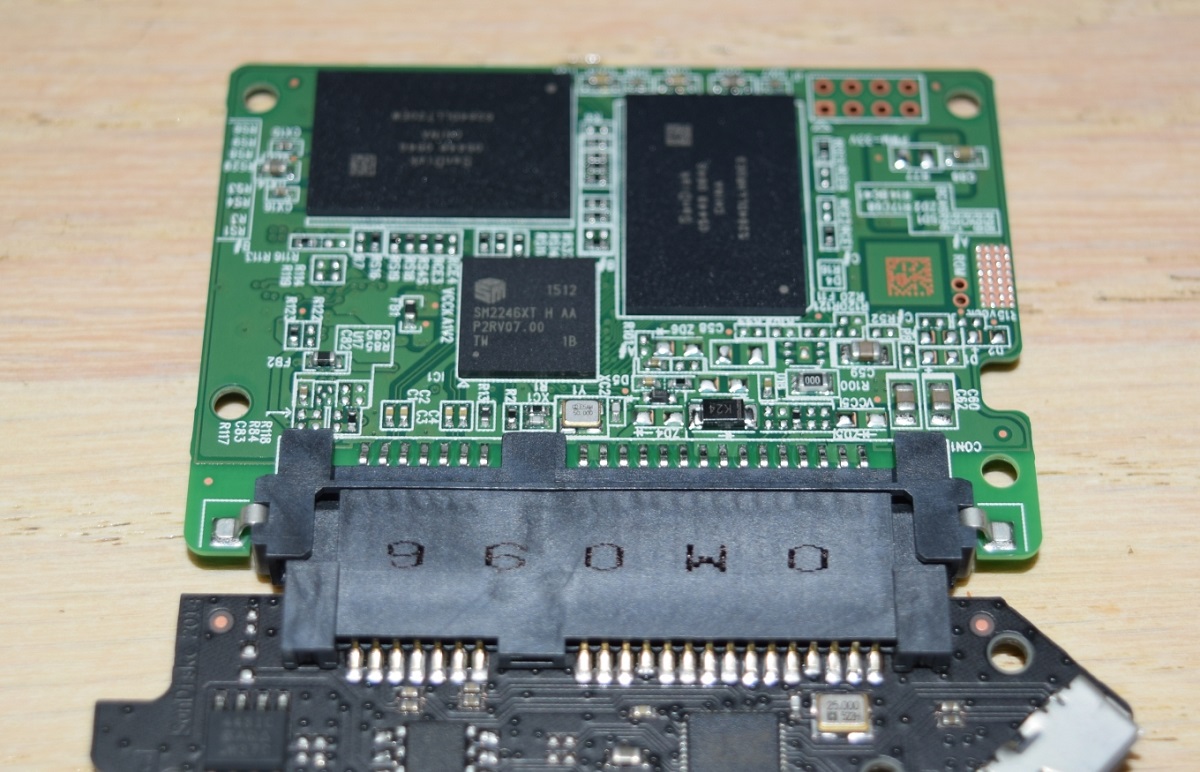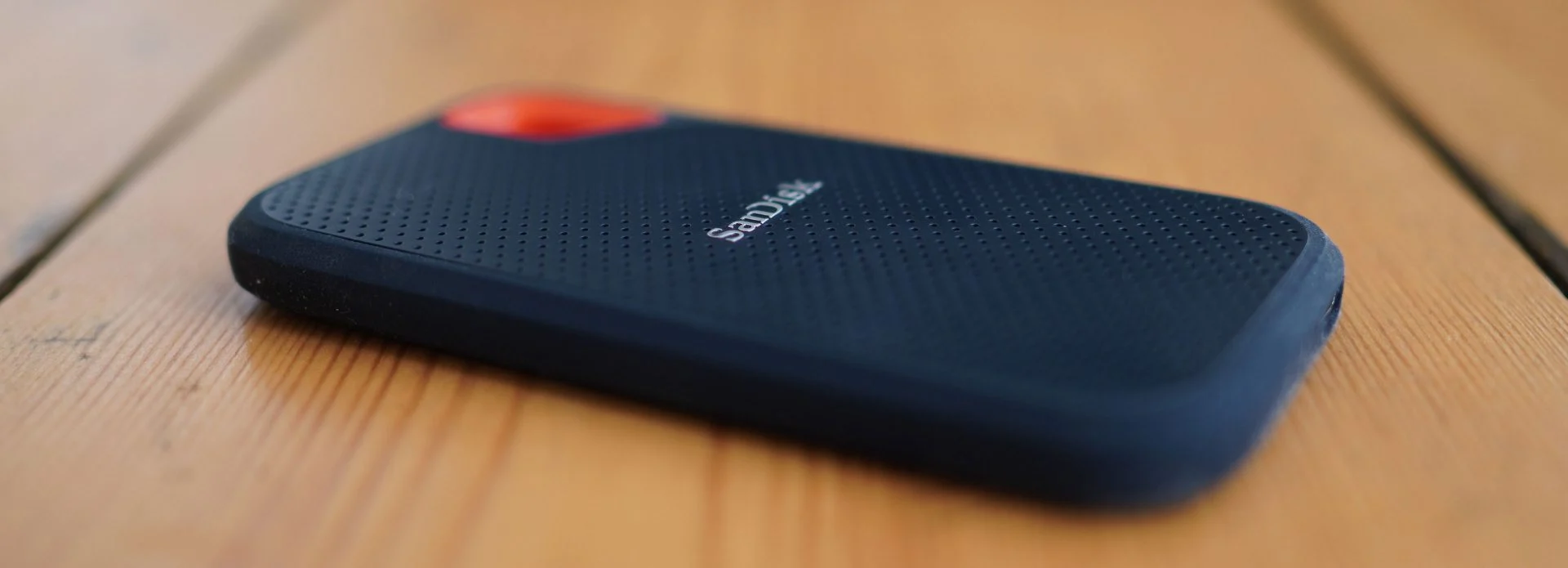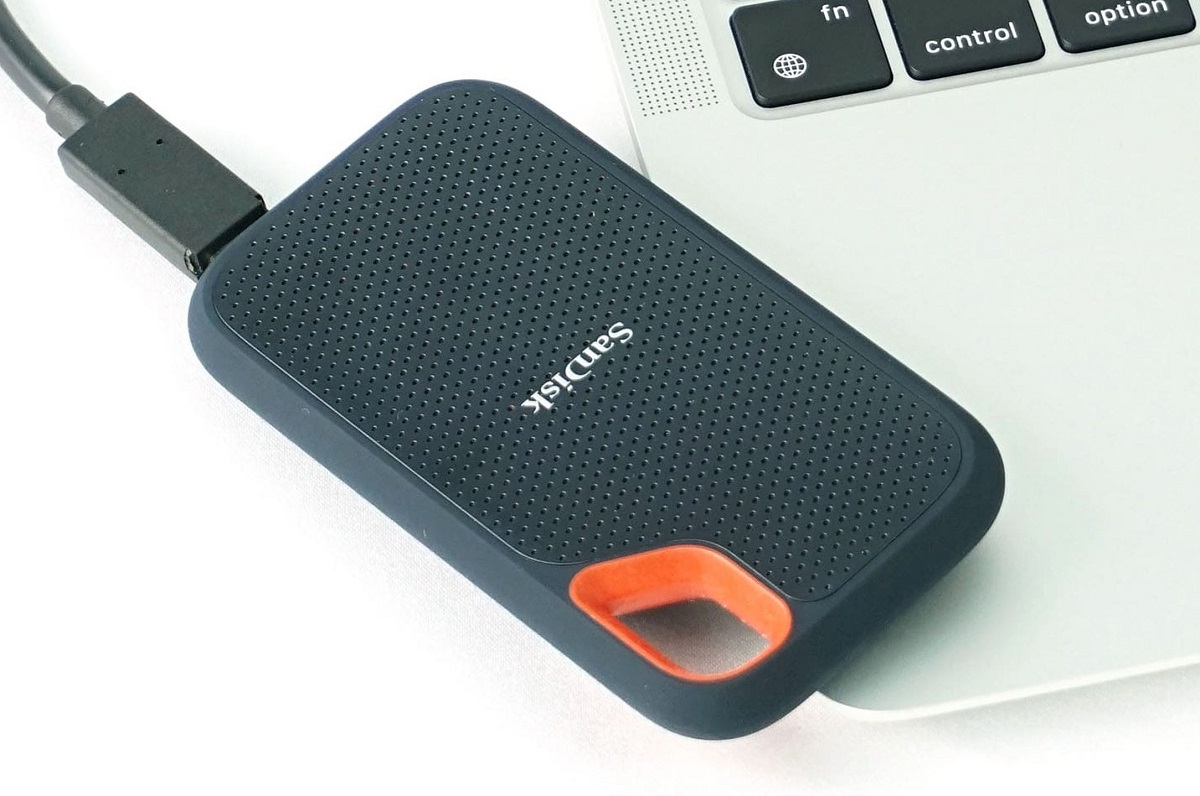Introduction
Welcome to the world of Sandisk Portable SSDs, the perfect solution for those who need reliable and fast storage on the go. In this digital age, where our lives are filled with vast amounts of data, having a reliable and portable storage solution is essential. Whether you are a photographer, videographer, graphic designer, or simply someone who wants to keep their files safe and accessible, Sandisk Portable SSDs are the answer.
With their compact and lightweight design, Sandisk Portable SSDs offer the convenience of being able to take your data with you wherever you go. No more worrying about running out of storage space on your laptop or dealing with slow transfer speeds. Sandisk Portable SSDs provide a seamless and efficient way to store and access your files.
But what exactly is a Sandisk Portable SSD? In simple terms, it is a portable solid-state drive that uses flash memory to store data. Unlike traditional hard drives, which rely on spinning disks, SSDs use NAND flash memory chips, resulting in faster data transfer speeds, lower power consumption, and increased durability.
By utilizing the latest USB technology, Sandisk Portable SSDs offer lightning-fast transfer speeds, allowing you to transfer large files in a matter of seconds. Whether you are transferring high-resolution photos, HD videos, or large software applications, Sandisk Portable SSDs can handle it all.
In this article, we will explore the benefits of using Sandisk Portable SSDs, how to connect them to your device, transfer data, use them as a backup solution, organize and manage files, safely eject them, and troubleshoot common issues. So, let’s dive in and discover how Sandisk Portable SSDs can revolutionize your storage experience.
What is Sandisk Portable SSD?
Sandisk Portable SSD is a cutting-edge storage device that offers high-performance and portable storage solutions for individuals who require fast and reliable data transfer. With its sleek and compact design, Sandisk Portable SSDs provide a convenient way to carry your digital files wherever you go.
Unlike traditional hard drives that use spinning disks, Sandisk Portable SSDs utilize solid-state technology. This means that instead of relying on mechanical parts, they store data on flash memory chips. This innovation provides several advantages, including faster data access, improved durability, and lower power consumption.
Sandisk Portable SSDs come in various capacities, ranging from a few hundred gigabytes to several terabytes. This allows you to choose the size that best suits your storage needs. Whether you are a professional photographer needing to store vast amounts of high-resolution images or a frequent traveler wanting to carry your multimedia library, Sandisk Portable SSDs have you covered.
One of the standout features of Sandisk Portable SSDs is their exceptional speed. Equipped with the latest USB technology, these devices offer ultra-fast data transfer rates that surpass those of traditional external hard drives. This means that you can transfer large files such as videos, photos, and documents in a matter of seconds, enhancing your productivity and saving you valuable time.
In addition to their speed, Sandisk Portable SSDs are also known for their durability. They are designed to withstand shocks, vibrations, and extreme temperature conditions, making them ideal for use in various environments. Whether you’re on a rugged outdoor adventure or working in a studio, you can trust that your data will remain safe and secure.
Another advantage of Sandisk Portable SSDs is their compatibility with a wide range of devices. Whether you are using a PC, Mac, or even a mobile device, you can easily connect and access your files with ease. With plug-and-play functionality, you don’t have to worry about complex setups or driver installations.
In summary, Sandisk Portable SSDs are innovative storage devices that provide high-performance, portable, and reliable storage solutions. With their compact design, lightning-fast transfer speeds, durability, and compatibility, they are the perfect choice for individuals who require on-the-go storage for their digital files.
Benefits of using Sandisk Portable SSD
Sandisk Portable SSDs offer a wide range of benefits that make them a preferred choice for individuals who need fast and reliable storage solutions. Let’s explore some of the key advantages of using Sandisk Portable SSDs:
1. Speed: Sandisk Portable SSDs provide lightning-fast data transfer speeds, allowing you to transfer files quickly and efficiently. Whether you are transferring large media files or working with demanding applications, you’ll experience significantly reduced wait times, resulting in improved productivity.
2. Portability: With their compact and lightweight design, Sandisk Portable SSDs are highly portable. You can easily slip them into your bag or pocket, making it convenient to carry your important files wherever you go. Whether you’re traveling for work or leisure, you can have your data readily accessible.
3. Durability: Sandisk Portable SSDs are built to withstand shocks, vibrations, and extreme temperatures. Unlike traditional hard drives with delicate moving parts, SSDs are more robust and resilient. This durability ensures your data remains safe and secure even in challenging environments.
4. Energy Efficiency: Sandisk Portable SSDs consume less power compared to traditional hard drives. This not only helps prolong the battery life of your device but also reduces energy consumption, contributing to a more sustainable and eco-friendly storage solution.
5. Compatibility: Sandisk Portable SSDs are compatible with a wide range of devices, including PCs, laptops, Macs, and even mobile devices. Whether you’re using Windows, macOS, or Linux, you can easily connect and access your files without the need for additional drivers or software installations.
6. Data Security: Sandisk Portable SSDs offer advanced data security features, including password protection and encryption. You can protect your sensitive files and confidential information, ensuring that only authorized individuals can access and view your data.
7. Versatile Applications: Sandisk Portable SSDs are not limited to data storage alone. They can be used for various purposes, such as running applications, creating bootable drives, or even as a temporary storage solution for gaming consoles. The versatility of Sandisk Portable SSDs ensures that they can adapt to your specific needs.
Overall, Sandisk Portable SSDs provide a superior storage experience with their speed, portability, durability, energy efficiency, compatibility, data security, and versatility. Invest in a Sandisk Portable SSD and enjoy the benefits of fast, reliable, and convenient storage for all your digital files.
How to connect Sandisk Portable SSD to your device
Connecting your Sandisk Portable SSD to your device is a straightforward process. Follow these simple steps to get started:
1. Check the compatibility: Before connecting your Sandisk Portable SSD, ensure that your device supports the USB interface used by your SSD. Sandisk Portable SSDs generally use USB 3.0 or USB-C interfaces, but it is important to verify the specific requirements of your device.
2. Gather the necessary cables: Depending on the model of your Sandisk Portable SSD and your device, you may need a USB-A to USB-A, USB-C to USB-A, or USB-C to USB-C cable. Make sure you have the appropriate cable on hand.
3. Power on your device: If your Sandisk Portable SSD does not have its own power source, ensure that your device is powered on and sufficiently charged. This will ensure a stable connection and prevent any unexpected disconnections during file transfers.
4. Connect the SSD to your device: Take the USB cable and plug one end into the USB port on your Sandisk Portable SSD. Then, connect the other end of the cable to an available USB port on your device. Make sure the connection is secure.
5. Wait for the device to recognize the SSD: Once the connection is made, your device should automatically recognize the Sandisk Portable SSD. It may take a few moments for the device to establish the connection and display the SSD as an available storage option.
6. Access the Sandisk Portable SSD: After your device has recognized the SSD, you can access it just like any other external storage device. Open your file explorer or finder and navigate to the Sandisk Portable SSD to view and manage your files.
7. Safely eject the SSD: When you’re finished using the Sandisk Portable SSD, it’s essential to properly eject it from your device to prevent data loss or corruption. On Windows, right-click on the drive and select “Eject.” On macOS, drag the SSD icon to the trash can or click the eject button next to the SSD in the Finder sidebar.
That’s it! You have successfully connected your Sandisk Portable SSD to your device. Now you can conveniently transfer, access, and manage your files with ease.
Transferring data to Sandisk Portable SSD
Transferring data to your Sandisk Portable SSD is a simple and efficient process. Whether you want to back up your important files or free up space on your device, follow these steps to transfer your data:
1. Connect your Sandisk Portable SSD: Start by connecting your Sandisk Portable SSD to your device using the appropriate USB cable. Ensure that both ends of the cable are securely plugged into the SSD and your device’s USB port.
2. Wait for the SSD to be recognized: Give your device a moment to recognize the Sandisk Portable SSD. It should appear as an external storage device in your file explorer or finder.
3. Open your file explorer or finder: Navigate to the location on your device where the files you want to transfer are stored. This could be your documents folder, desktop, or any other relevant location.
4. Select the files you want to transfer: Use your mouse or trackpad to select the files or folders you want to transfer to your Sandisk Portable SSD. You can select multiple files by holding down the CTRL or CMD key while clicking on the files.
5. Copy or cut the selected files: Once you have selected the files, right-click on them and choose either “Copy” or “Cut” from the context menu. “Copy” will create a duplicate of the files on your Sandisk Portable SSD, while “Cut” will remove them from their current location and move them to the SSD.
6. Access your Sandisk Portable SSD: Go back to your file explorer or finder and locate your Sandisk Portable SSD. Open it to view the contents of the SSD.
7. Paste the files to the SSD: Right-click inside the Sandisk Portable SSD’s folder and choose “Paste” from the context menu. This will transfer the selected files from your device to the SSD. Alternatively, you can use the keyboard shortcut CTRL+V (Windows) or CMD+V (Mac) to paste the files.
8. Monitor the transfer progress: Depending on the size and number of files being transferred, it may take some time to complete the transfer. Keep an eye on the progress bar or notification to ensure that all files are successfully copied or moved to the Sandisk Portable SSD.
9. Verify the transferred files: Once the transfer is complete, go to the Sandisk Portable SSD’s folder and check that all the transferred files are present and intact. You can open them to confirm that they are accessible and functional.
That’s it! You have successfully transferred your data to your Sandisk Portable SSD. You can now safely disconnect the SSD from your device and carry your files with you wherever you go.
Using Sandisk Portable SSD as a backup solution
Sandisk Portable SSDs are not only a reliable storage solution but also an excellent choice for backing up your important data. Whether you want to protect your personal photos, videos, documents, or any other valuable files, utilizing your Sandisk Portable SSD as a backup device offers several benefits. Here’s how you can use it as a backup solution:
1. Determine the data to be backed up: Identify the files and folders that you want to include in your backup. This may include documents, photos, videos, music, and any other files that you consider essential.
2. Create a backup schedule: Decide on a frequency for conducting backups. Regular backups are vital to ensure your data is up to date and protected. Consider scheduling automatic backups on a daily, weekly, or monthly basis, depending on the frequency with which your data changes.
3. Connect your Sandisk Portable SSD: Connect your Sandisk Portable SSD to your device using the appropriate USB cable. Ensure that the SSD is recognized by your system and is accessible in your file explorer or finder.
4. Select the files to be backed up: Open your file explorer or finder and navigate to the files and folders you want to back up. Use your mouse or trackpad to select these items.
5. Copy the selected files to the Sandisk Portable SSD: Right-click on the selected files and folders, then choose “Copy” from the context menu. Navigate to the location on your Sandisk Portable SSD where you want to store the backup files, right-click, and choose “Paste” to initiate the copying process.
6. Verify the backup: Once the backup process is complete, double-check the copied files on your Sandisk Portable SSD for accuracy and completeness. Open some files to ensure they are accessible and intact.
7. Encrypt your backup (optional): For enhanced security, consider encrypting your backup files on the Sandisk Portable SSD. You can utilize built-in encryption tools provided by your operating system or third-party encryption software to protect your data from unauthorized access.
8. Store your Sandisk Portable SSD in a safe location: After the backup is complete, store your Sandisk Portable SSD in a secure location away from potential hazards such as extreme temperatures, moisture, and physical damage. Consider keeping it in a fireproof and waterproof safe or a locked drawer for maximum protection.
9. Perform regular backup updates: It is crucial to keep your backups up to date by regularly adding new or changed files. Set a reminder to perform routine backups or consider utilizing automated backup software that can synchronize your data between your device and your Sandisk Portable SSD.
By utilizing your Sandisk Portable SSD as a backup solution, you can ensure the safety of your important data in case of device failure, theft, or accidental deletion. Always remember to keep multiple copies of your backups, including storing them on cloud storage or another physical location, for added redundancy and peace of mind.
Organizing and managing files on Sandisk Portable SSD
Effectively organizing and managing your files on your Sandisk Portable SSD will not only make it easier to locate and access specific files but also help optimize its storage capacity. Here are some tips to help you organize and manage your files:
1. Create a folder structure: Start by creating a logical folder structure on your Sandisk Portable SSD. Think about how you want to categorize your files and create main folders for each category. For example, you could have folders for documents, photos, videos, and music.
2. Subdivide folders: Within each main folder, further subdivide your files into more specific folders. For instance, within the documents folder, you can create separate folders for work-related documents, personal documents, or specific projects.
3. Use descriptive file names: Give your files descriptive and meaningful names that reflect their content. This will make it easier to identify files when browsing through your folders and performing searches.
4. Utilize metadata and tags: Take advantage of metadata and tagging features provided by your operating system or file management software. These features allow you to add additional information to your files, such as keywords, dates, and categories, making it easier to search and filter your files later.
5. Sort files by date or type: Arrange your files within each folder by date or file type. This can be especially helpful when dealing with large quantities of files, allowing you to quickly locate the most recent files or specific file types.
6. Regularly review and delete unnecessary files: Periodically go through your folders and delete any files that are no longer needed. This will help free up space on your Sandisk Portable SSD and avoid clutter.
7. Use file backup and synchronization software: Consider using file backup and synchronization software that can automatically backup your files to your Sandisk Portable SSD and keep them updated. This can help streamline the management of your files and ensure you always have a current backup.
8. Secure your files: If you are dealing with sensitive or confidential files, consider implementing encryption or password protection to enhance the security of your files on your Sandisk Portable SSD.
9. Regularly defragment (for HDD-based SSDs): If you are using a Sandisk Portable SSD that relies on HDD technology, consider defragmenting your files periodically. This process reorganizes the files on your SSD, improving performance and optimizing storage space.
By following these tips, you can effectively organize and manage your files on your Sandisk Portable SSD, making it easier to locate, access, and maintain your digital assets. Take the time to establish a file organization system that works for you and regularly review and update it as your file collection grows.
How to safely eject Sandisk Portable SSD from your device
Properly ejecting your Sandisk Portable SSD from your device is crucial to prevent data loss or corruption. Safely removing the SSD ensures that all file transfers are complete and that the device is ready to be disconnected. Here’s how you can safely eject your Sandisk Portable SSD:
1. Save and close any open files: Before ejecting your Sandisk Portable SSD, make sure to save and close any open files or applications that are running from or accessing the SSD. This ensures that all data is successfully written to the device.
2. Locate the ejection option: On your device’s operating system, there are different ways to access the ejection option for external devices such as Sandisk Portable SSDs. You can typically find it as an icon in the taskbar or system tray, or you can right-click on the Sandisk Portable SSD icon in your file explorer or finder.
3. Eject the Sandisk Portable SSD: Click on the ejection option, which is often represented as an arrow or a small icon of a USB device being removed. This initiates the ejection process and prepares the Sandisk Portable SSD for safe removal.
4. Wait for the confirmation: After initiating the ejection, wait for your operating system to display a confirmation message indicating that it is safe to remove the Sandisk Portable SSD. This message will typically state that it is now safe to disconnect the device.
5. Physically disconnect the SSD: Once you receive the confirmation message, you can proceed to physically remove the Sandisk Portable SSD from your device. Gently unplug the USB cable from both the SSD’s port and your device’s USB port. Ensure that you do not forcefully remove the SSD to avoid any potential damage.
6. Store the Sandisk Portable SSD safely: After safely ejecting and disconnecting the Sandisk Portable SSD, ensure that you store it in a safe and secure location. Protect the SSD from physical damage and keep it away from extreme temperatures, moisture, and magnetic fields.
7. Verify the ejection: To double-check that the ejection was successful, open your file explorer or finder, and verify that the Sandisk Portable SSD is no longer listed as an available storage device. This confirms that the SSD has been safely removed from your device.
Following these steps guarantees that you properly eject your Sandisk Portable SSD, minimizing the risk of data loss or corruption. By taking the extra moment to safely disconnect the SSD from your device, you ensure its longevity and maintain the integrity of your files.
Troubleshooting common issues with Sandisk Portable SSD
While Sandisk Portable SSDs are known for their reliability, occasionally, you may encounter some common issues. Here are some troubleshooting steps to help you resolve these problems:
1. Connectivity issues: If your Sandisk Portable SSD is not being recognized by your device, try the following steps:
– Ensure that the USB cable is securely connected to both the SSD and your device.
– Try plugging the SSD into a different USB port on your device.
– Test the SSD on another device to determine if the issue is with the device or the SSD itself.
2. Slow transfer speeds: If you’re experiencing slow transfer speeds, consider the following:
– Use a USB 3.0 or USB-C port to take advantage of faster transfer rates.
– Make sure that the USB cable you are using supports the maximum transfer speed of your Sandisk Portable SSD.
– Check for any background processes or applications that may be utilizing the device’s resources, causing slower transfer speeds.
3. Incompatibility with a specific device: If your Sandisk Portable SSD is not compatible with a particular device, try these steps:
– Ensure that the device’s operating system and drivers are up to date.
– Check the Sandisk website for any firmware updates for your specific SSD model.
– Consult the device and SSD documentation for compatibility requirements and specifications.
4. Corrupted files or data loss: If you encounter corrupted files or experience data loss, try these solutions:
– Ensure that you have safely ejected the Sandisk Portable SSD before disconnecting it from your device to prevent file corruption.
– Use data recovery software to attempt to recover any lost or inaccessible files.
– Regularly back up your data on multiple devices or cloud storage to minimize the risk of permanent data loss.
5. Insufficient storage space: If you’re running out of storage space on your Sandisk Portable SSD, consider the following options:
– Delete any unnecessary or duplicate files from the SSD to free up space.
– Transfer larger files to other storage devices or cloud storage to reduce the SSD’s storage usage.
– Consider upgrading to a higher-capacity Sandisk Portable SSD if your storage needs exceed the current capacity.
6. Device overheating: If your Sandisk Portable SSD is heating up, try the following solutions:
– Ensure that the SSD is not covered or obstructed, allowing proper airflow for cooling.
– Avoid using the SSD on soft surfaces that can block heat dissipation.
– If the SSD continues to overheat, contact the Sandisk customer support for further assistance.
If you continue to experience issues with your Sandisk Portable SSD, it is recommended to reach out to Sandisk customer support. They can provide tailored solutions or assist you with potentially replacing the SSD if it is determined to be defective.
Conclusion
Sandisk Portable SSDs provide a reliable and efficient solution for on-the-go storage needs. Their compact design, fast transfer speeds, durability, and compatibility make them the perfect choice for professionals and individuals who require portable and high-performance storage.
In this article, we explored the various features and benefits of Sandisk Portable SSDs, including their speed, portability, durability, energy efficiency, compatibility, data security, and versatility. We learned how to connect the SSD to our devices, transfer data to it, use it as a backup solution, organize and manage files, safely eject it, and troubleshoot common issues that may arise.
By following the recommended best practices, such as creating a logical folder structure, utilizing metadata and tags, and regularly reviewing and deleting unnecessary files, you can effectively organize and manage your files on your Sandisk Portable SSD, ensuring efficient access and optimal storage capacity utilization.
It is important to keep your Sandisk Portable SSD updated with the latest firmware and to practice safe data handling by regularly backing up your files and properly ejecting the device from your computer or device before disconnecting. This helps to minimize the risk of data loss or corruption.
Whether you are a photographer, videographer, graphic designer, or simply someone who needs a reliable storage solution for your important files, Sandisk Portable SSDs offer the performance, convenience, and durability you need. With their exceptional speed, portability, and security features, you can confidently store, access, and transport your data knowing that it is safe and readily available.
Investing in a Sandisk Portable SSD can revolutionize your storage experience, providing you with the peace of mind and convenience you deserve in today’s digital landscape.









